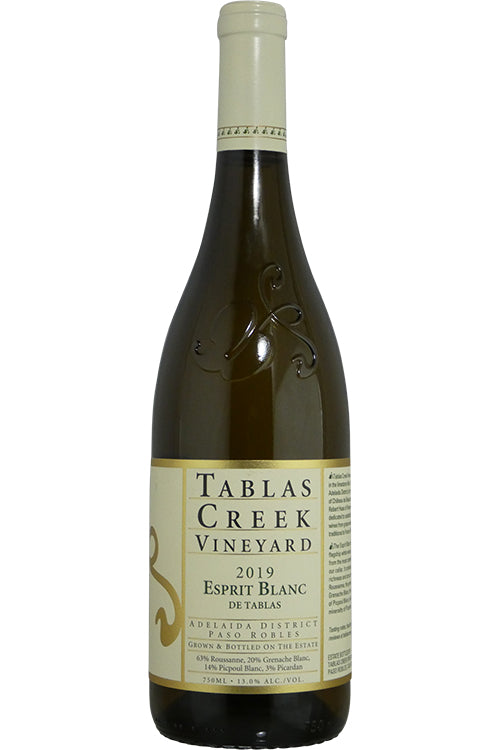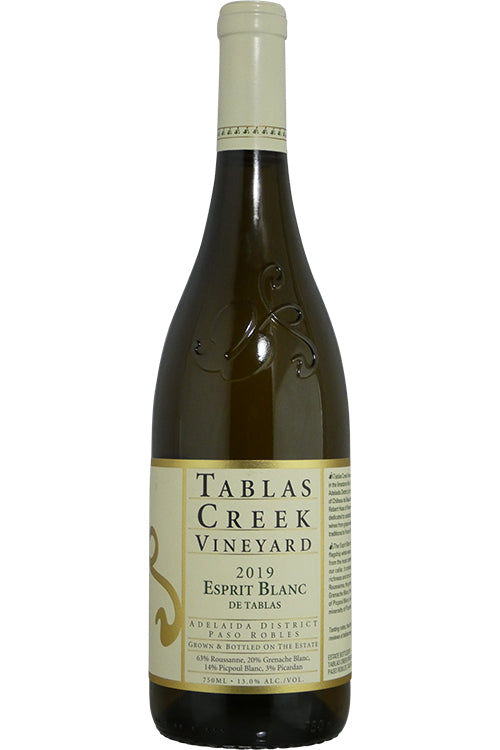1
/
of
1
Tablas Creek Esprit de Tablas Blanc - 2021 (750ml)
Tablas Creek Esprit de Tablas Blanc - 2021 (750ml)
Regular price
$58.99
Sale price
$58.99
Regular price
$64.99
Unit price
/
per
Vivid yellow. Assertively perfumed orange zest, nectarine and pineapple aromas, along with building floral and smoky mineral flourishes. Shows fine definition and tension on the palate, offering intense citrus and pit fruit flavors braced by a core of juicy acidity. Lingers with superb tenacity on the finish, which strongly echoes the mineral and floral notes.
Vinous - 94 points
Vinous - 94 points
Availability:
7 In Stock
$25 Shipping on Orders +$299
Couldn't load pickup availability
Share :

- varietal
- Region
- Sub - Region
- Type
- Reviews
Product Review
The Tablas Creek Vineyard 2019 Esprit de Tablas Blanc is our flagship white blend, chosen from the top lots of four estate-grown varietals propagated from budwood cuttings from the Château de Beaucastel estate. Roussanne provides the core richness, minerality, and flavors of honey and spice, while Grenache Blanc adds green apple and anise flavors, a lush mouthfeel and bright acids. Picpoul Blanc adds pineapple brightness and saline minerality while Picardan brings elegance.
Indigenous to the Rhone Valley, Roussanne is capable of producing some of the richest and fullest bodied white wines. Its name is derived from Roux (French for russet) due to the copper tinge it develops on the vine. Its nose displays evocative notes of ripe pears, apricots, honey, and tea leaf, which when combined with its marked acidity make it an easily distinguishable varietal. Becoming increasingly fashionable in the Rhone where it is fleshed out with its field buddy Marsanne, it forms the white wines of St. Joseph, Hermitage, Crozes Hermitage and St. Peray. The latter of which makes a sparkling wines from its grapes. It is also one of four white grapes permitted in the southern Rhone village of Chateauneuf-du-Pape adding additional aromatic complexity to the key red grapes Grenache Syrah and Mouvedre. Chateau de Beaucastel are a great example of a Rhone producer utilizing the grape in varietal form. Thanks to the California's dedicated Rhone Rangers, the grape is spreading across more of the new World with pioneering Central Coast wineries such as Tablas Creek and Alban Vineyards. While area under vines in California is still small (177 acres as of 2005) it is also taking off in parts of Sonoma as well as high elevation sites in the Sierra Foothills, and parts of Washington State.
California is one of the most diverse wine producing regions of the world. Although it has a history spanning over 200 years, it has experienced most of its growth in the last fifty years. The regions of Napa Valley and Sonoma County have become as renowned as France’s Bordeaux and Burgundy. While Cabernet Sauvignon, Pinot Noir, and Chardonnay are by far the most popular fine wine varieties, producers in the Golden State have also experimented with an unparalleled array of diverse varieties, including Zinfandel, Syrah, Nebbiolo, Sangiovese, and Tempranillo.
Paso Robles was the largest un-subdivided AVA within California at approximately 614,000 acres. By contrast, the Napa Valley appellation (which includes sixteen AVA's delineated within its bounds) is roughly one-third the area at 225,000 acres. Since the Paso Robles AVA was established in 1983, Paso Robles has grown to encompass 200+ wineries and 32,000 vineyard acres. This vineyard acreage is spread over a sprawling district roughly 42 miles east to west and 32 miles north to south. Average rainfall varies from more than 30 inches a year in extreme western sections to less than 10 inches in areas farther east. Elevations range from 700 feet to more than 2400 feet. Soils differ dramatically in different parts of the AVA, from the highly calcareous hills out near us to sand, loam and alluvial soils in the Estrella River basin. The warmest parts of the AVA accumulate roughly 20% more heat (measured by growing degree degree days) than the coolest; the average year-to-date degree days in the Templeton Gap since 1997 is 2498, while in Shandon far out east it's 2956. This difference in temperatures is enough to make the cooler parts of the AVA a Winkler Region II in the commonly used scale of heat summation developed at UC Davis, while the warmest sections are a Winkler Region IV.
White wine is a wine whose color can be pale-yellow, yellow-green, and yellow-gold colored. The wine is produced from a variety of grape varieties. The flavor and color comes from the juice of the grape and sometimes the skin of the grape as well. Interestingly, not all white wine comes from white grapes. Some select red grapes are used as in Champagne.


